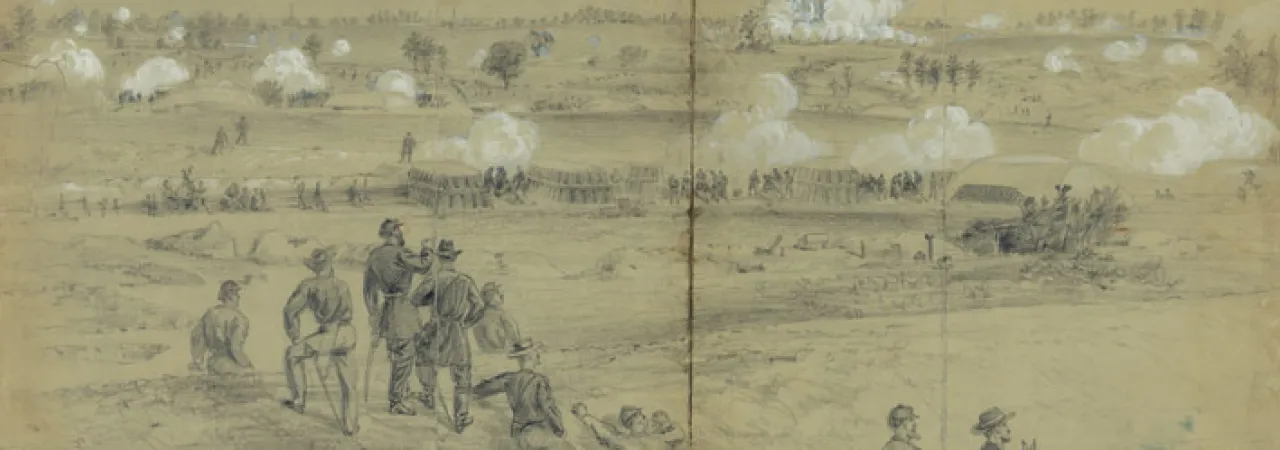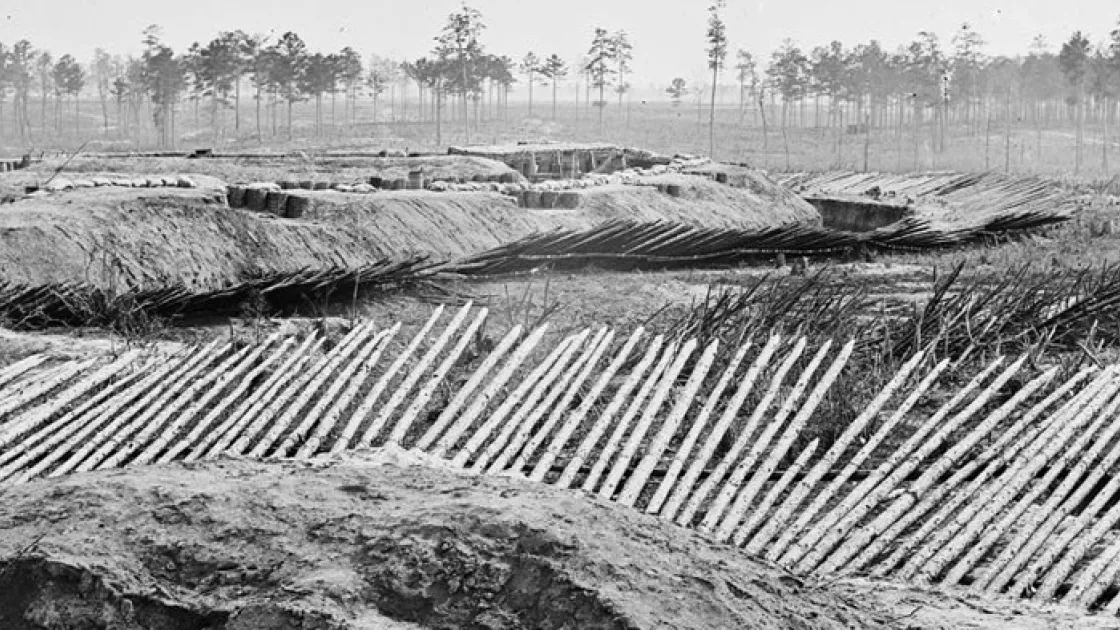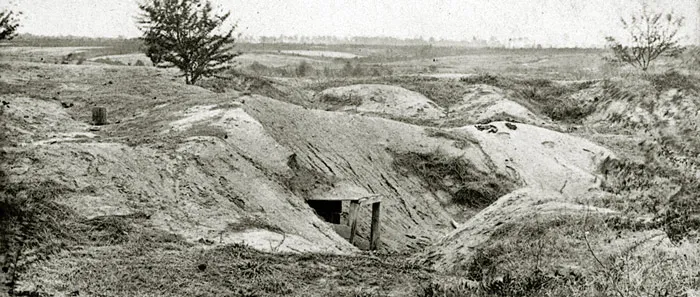
The Battles and Siege of Petersburg are a particularly complex and broad series of actions that spanned some 10 months and hundreds of square miles. To get you started, here are 10 facts (plus more) about Petersburg.
Fact #1: In 1860, Petersburg was the second largest city in Virginia and the seventh largest in the Confederacy.
Nestled at the head of navigation on the south bank of the Appomattox River, Petersburg had been a tobacco, cotton, and iron manufacturing center before the Civil War as well as an important domestic port. By 1864, however, its significance resided in the five railroads that connected Petersburg with Richmond and points south and west.
Fact #2: Petersburg’s transportation nexus made it an attractive target for General Ulysses S. Grant in June 1864.
The Union general-in-chief had run out of maneuver room north of the James River in his twin quest to cripple General Robert E. Lee’s Army of Northern Virginia and capture Richmond. A swift and secret move across the “mighty James” against Petersburg promised to isolate the Confederate capital and place Lee at a severe disadvantage.
Fact #3: The Petersburg Campaign encompassed 292 days of combat, maneuver, and trench warfare between June 15, 1864, and April 2, 1865.
From June 15-17, 1864, the outnumbered Confederate General Beauregard and his troops saved Petersburg from Union capture. He created a third defensive line along high ground closer to the city and occupied it on the morning of June 18, welcoming reinforcements from Lee’s Army of Northern Virginia. The appearance of Lee’s men ended Federals’ hopes to take Petersburg by storm and ensured a lengthy siege and seemingly endless fighting. For the next nine months, Grant focused on severing Petersburg’s many wagon and rail connections to the south and west. Four offensives between June and October made incremental gains. By the end of the 1864 campaign season, Lee could rely on only a makeshift supply line via the Boydton Plank Road and the South Side Railroad to maintain communications with the south.

Fact #4: The largest regimental loss of the Civil War was sustained by the 1st Maine Heavy Artillery at Petersburg.
On June 18, 1864, the 850 men of the 1st Maine Heavy Artillery advanced across a cornfield when the Confederate line erupted in sheets of flame. Supporting units failed to protect their flanks, and the men of the 1st Maine found themselves subjected to fire that seemingly hit from every angle. Within ten minutes, a staggering 632 men lay dead or wounded on the field, and not a single man had come close to reaching the enemy line.
Fact #5: On July 30, 1864, Pennsylvanians exploded four tons of explosives under the Confederate line and created the most famous American military crater.
The 48th Pennsylvania Infantry excavated a 510-foot tunnel beneath a Confederate fort southeast of Petersburg. They packed the galleries with 8,000 pounds of powder and ignited the fuse. The blast created a huge gap in the Confederate line, sending more than 300 South Carolinians to their graves. The attacks that followed failed to match the engineering success. Poor planning, communications, and leadership robbed the Battle of the Crater of its potentially decisive results. Bold Confederate counterattacks repaired the breach, focusing particular bitterness upon the black troops who participated in the assaults. Grant pronounced it “the saddest affair I have witnessed in this war.”

Fact #6: Supply operations at nearby City Point all but assured the success of the Union campaign against Petersburg.
After his failure to take Petersburg by storm, Generals Grant and Meade created a massive support operation at City Point, where the James and Appomattox Rivers met. Grant’s headquarters was established there, and the Union army literally created a city (now Hopewell, Virginia), where a declining ex-river port had once stood. Huge wharves, a busy harbor, a giant government bakery and an immense hospital, highlighted the operations.
Fact #7: Most of General Grant’s major offensives were launched southwest and west of Petersburg from September 1864 to April 1865.
Significant actions at Peebles Farm, Burgess’ Mill, Hatcher’s Run, White Oak Road, Five Forks and the Breakthrough targeted Lee’s remaining supply lines—the Boydton Plank Road and the Southside Railroad—which ultimately ushered in Union success.
Fact #8: April 2, 1865, proved to be the day of decision at Petersburg.
The Union Sixth Corps broke through the Confederate defenses southwest of the city, and Lee notified President Jefferson Davis that it would be necessary to evacuate Richmond and Petersburg that night. Vicious fighting the rest of the day allowed the beleaguered Confederates to maintain their inner defenses until nightfall shielded their successful withdrawal. Lee hoped to reach General Joseph Johnston’s army in North Carolina to continue the war.
Fact #9: Petersburg remains the longest siege in American history but was not a siege, at least in the traditional sense.
Most accounts of the Petersburg operations refer to the actions as a siege but a siege, accurately defined, entails the surrounding and blocking reinforcement or escape of an enemy force. Robert E. Lee was never trapped at Petersburg—he could leave at will. Nor did the Federal forces conduct formal siege warfare by advancing trenches toward the Confederate lines. Comparing Ulysses S. Grant’s situation at Vicksburg, Mississippi, in 1863 with his Petersburg operations reveals the stark distinction between a true siege and the events at Petersburg.
Fact #10: The Battles and Siege of Petersburg involved more than 180,000 soldiers and produced some 60,000 casualties.
The armies at Petersburg were in almost constant transition, making the determination of troop strength a moving target. In general, Union troop strength exceeded that of the Confederates by nearly two-to-one for most of the campaign. Even at the end of the campaign, on April 2, 1865, Lee evacuated more than 50,000 men out of Richmond and Petersburg, while Grant’s combined armies counted at least 110,000 men by that time. Although precise figures are hard to come by, the best estimates suggest 42,000 Union casualties and 28,000 Confederate casualties, in total.

Bonus Facts:
- Some cite the “Battle of Old Men and Young Boys” on June 9, 1864, as the true beginning of the campaign, instead of the more traditionally used date of June 15, 1864.
- The Federal forces at Petersburg belonged to three armies-- the Army of the Potomac, the Army of the James, and the Army of the Shenandoah which arrived at Petersburg on March 25, 1865.
- Two Confederate armies fought at Petersburg-- the Department of North Carolina and Southern Virginia, held the Petersburg lines alone from June 15 through June 17 until the arrival of the Army of Northern Virginia.
- The operations at Petersburg covered roughly 576 square miles.
- Union troops moved into Petersburg on April 3. Six days later, Lee rendezvoused not with Johnston but with Grant at Appomattox Court House, ending the war in Virginia.
- While General Grant commanded all the Union armies at Petersburg, Union General George G. Meade commanded the largest army there—the Army of the Potomac.
- Lee was utterly surprised by the choice of Petersburg as the target Union operations.
- Lee and his army did not arrive at Petersburg until June 18—a full nine days after the first attacks on the city began.
- Confederate spies made numerous attempts to sabotage City Point and succeeded partly using a time bomb planted on a munitions ship in August 1864.
- On March 25, 1865, General Lee launched a massive attack against Union Fort Stedman, east of Petersburg hoping to draw Federal troops away from the western extension of their lines. The attack fails and Lee returns to his fortifications, badly bloodied.
- General Grant launched nine distinct offensives at Petersburg, usually striking simultaneously north and south of the James River:
- 1st Offensive, June 15-18, 1864: Grant’s attacks on the eastern Petersburg defenses force Beauregard back toward the city.
- 2nd Offensive, June 22-24, 1864: Grant targets the Petersburg (Weldon) Railroad, but Confederate counterattacks limit his gain to the capture of the Jerusalem Plank Road.
- 3rd Offensive, July 26-30, 1864: Results in the operations at First Deep Bottom north of the James River and the Battle of the Crater on July 30 southeast of Petersburg.
- 4th Offensive, August 12-21, 1864: Second Deep Bottom north of the James River and the Battle of Weldon Railroad south of Petersburg.
- 5th Offensive, September 29-October 2, 1864: Union gains north of the James River at New Market Heights and Fort Harrison. Southwest of Petersburg, the Union attackers extend their lines three miles westward but fail to capture Lee’s two remaining supply lines.
- 6th Offensive, October 27, 1864: Sharp but inconsequential fighting north of the James River. Southwest of Petersburg, Northern troops briefly occupy the Boydton Plank Road near Burgess’s Mill, but Confederate counterattacks drive them back, ending active campaigning for the year.
- 7th Offensive, February 5-7, 1865: Grant exploits mild weather to target the Boydton Plank Road. The Battle of Hatcher’s Run ensues, and although the Confederates preserve their supply routes, both armies extend their fortifications several miles further west.
- 8th Offensive, March 27-April 1: Grant captures the Boydton Plank Road and opens a clear path to the South Side Railroad. Battles at Lewis Farm, White Oak Road, Dinwiddie Court House, and Five Forks leave the Confederates on the brink of disaster.
- 9th Offensive, April 2: Results in his Sixth Corps breaking the Confederate line southwest of Petersburg at dawn. Lee plans to evacuate Richmond and Petersburg that night, and desperate fighting at Fort Mahone, Fort Gregg, Edge Hill, and Sutherland Station buy him time to do so.
Learn More: Petersburg | The Crater | Reams Station | Fort Stedman | Five Forks | The Breakthrough
Related Battles
488
679
2,899
1,500
1,539
1,000
3,500
4,250
8,150
3,236





